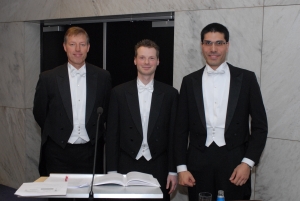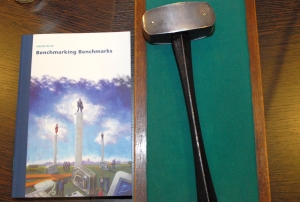Benchmarking Benchmarks
 Do current benchmark asset pricing models adequately describe the cross-section of stock returns? David Blitz believes that these benchmarks can be challenged, and proposes new ones. In his thesis, Benchmarking Benchmarks, Blitz presents a momentum strategy based on residual stock returns that vastly improves upon traditional momentum strategies.
Do current benchmark asset pricing models adequately describe the cross-section of stock returns? David Blitz believes that these benchmarks can be challenged, and proposes new ones. In his thesis, Benchmarking Benchmarks, Blitz presents a momentum strategy based on residual stock returns that vastly improves upon traditional momentum strategies.
For equity markets Blitz argues that some commonly used benchmarks are suboptimal, some key effects are ignored and some supposedly revolutionary new benchmarks are essentially old wine in new bottles. He also shows that the benchmark-driven asset allocation processes of institutional investors may leave money on the table that can be exploited with tactical cross-asset allocation and dynamic strategic asset allocation strategies. Finally, he shows that theoretical benchmark returns are not necessarily attainable in practice.
The results of this thesis can be used by (quantitative) fund managers and by institutional investors, such as pension funds, to rethink their current investment approach and improve their expected return and/or reduce risk. The results also have implications for the debate on active versus passive investing, as the performance of passive funds in practice lowers the bar for active funds significantly compared to theoretical benchmark returns that are commonly used for performance evaluation purposes.
David Blitz defended his dissertation on March 3, 2011 at Erasmus School of Economics, Erasmus University. His promotors were Prof.dr. Angelien Kemna and Prof.dr. Willem Verschoor. Other members of the doctoral committee were Prof.dr. D.J.C. van Dijk, Prof.dr. M.J.C.M. Verbeek, and Prof.dr. T.B.M. Steenkamp.
About David Blitz
David Blitz was born in Rotterdam on July 24, 1973. He attended the Christelijke Scholengemeenschap Henegouwerplein in Rotterdam, at which he obtained a VWO diploma in 1991. From 1991 to 1995 David studied at Erasmus University Rotterdam. In 1995 he completed his doctoraal in Business Econometrics with appellation cum laude. In August 1995 he joined the Quantitative Research department of the Institute for Research and Investment Services (IRIS), a joint-venture of Rabobank and Robeco. In 1998 this team was transferred to Robeco’s asset management division. In 2000 David became responsible for coordinating the quantitative equity research efforts. A few years later, Robeco introduced its first purely quantitative equity product. By the end of the decade, this business had grown to well over 10 billion euros assets under management. In 2008 David became co-head of the Quantitative Strategies department, as it was called by then. As a spin-off of his research David has published papers in the Journal of Portfolio Management, European Financial Management, Applied Financial Economics, Journal of Asset Management, Journal of Performance Measurement and the VBA Journaal. The paper “The Volatility Effect”, authored by David Blitz and Pim van Vliet, was one of the winners of the Emerald Citation of Excellence awards in 2007. David’s research interests include the cross-section of stock returns, asset allocation and applied quantitative investing in general.
Abstract of Benchmarking Benchmarks
 Benchmarking benchmarks is a bundle of six studies that are inspired by the prevalence of benchmarking in academic finance research as well as in investment practice. Three studies examine if current benchmark asset pricing models adequately describe the cross-section of stock returns. We present a momentum strategy based on residual stock returns that vastly improves upon traditional momentum strategies, evidence that low-volatility stocks earn abnormally high risk-adjusted returns and a critical discussion of the recently proposed “fundamental indexation” approach. Two studies examine whether active asset allocation can add value over a benchmark strategic asset allocation (SAA) portfolio. We empirically find that value and momentum effects do not only exist within, but also across asset classes, and we present a practical framework for dynamic strategic asset allocation based on the business cycle. The final study examines whether benchmark index returns can actually be obtained in reality. We find that passive funds listed in Europe lag their benchmarks by a statistically and economically significant amount of 50-150 basis points per annum, as a result of expenses and dividend taxes. Based on the overall results we hypothesize that the phenomenon of benchmarking itself may lie at the root of some of our key findings and that the challenge is to adapt benchmarks in such a way that desired behavior is better encouraged.
Benchmarking benchmarks is a bundle of six studies that are inspired by the prevalence of benchmarking in academic finance research as well as in investment practice. Three studies examine if current benchmark asset pricing models adequately describe the cross-section of stock returns. We present a momentum strategy based on residual stock returns that vastly improves upon traditional momentum strategies, evidence that low-volatility stocks earn abnormally high risk-adjusted returns and a critical discussion of the recently proposed “fundamental indexation” approach. Two studies examine whether active asset allocation can add value over a benchmark strategic asset allocation (SAA) portfolio. We empirically find that value and momentum effects do not only exist within, but also across asset classes, and we present a practical framework for dynamic strategic asset allocation based on the business cycle. The final study examines whether benchmark index returns can actually be obtained in reality. We find that passive funds listed in Europe lag their benchmarks by a statistically and economically significant amount of 50-150 basis points per annum, as a result of expenses and dividend taxes. Based on the overall results we hypothesize that the phenomenon of benchmarking itself may lie at the root of some of our key findings and that the challenge is to adapt benchmarks in such a way that desired behavior is better encouraged.


